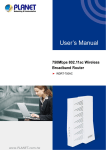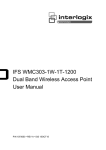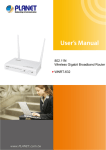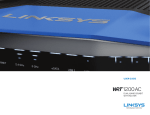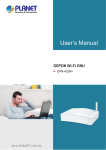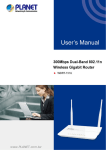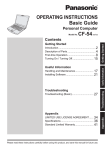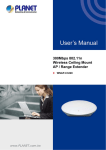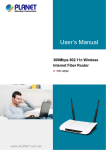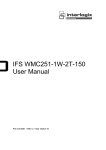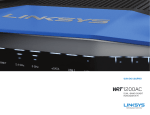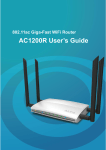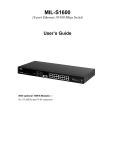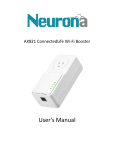Download User Manual
Transcript
Copyright
Copyright 2014 by PLANET Technology Corp. All rights reserved. No part of this publication may be
reproduced, transmitted, transcribed, stored in a retrieval system, or translated into any language or computer
language, in any form or by any means, electronic, mechanical, magnetic, optical, chemical, manual or
otherwise, without the prior written permission of PLANET.
PLANET makes no representations or warranties, either expressed or implied, with respect to the contents
hereof and specifically disclaims any warranties, merchantability or fitness for any particular purpose.
Any
software described in this manual is sold or licensed "as is". Should the programs prove defective following their
purchase, the buyer (and not this company, its distributor, or its dealer) assumes the entire cost of all necessary
servicing, repair, and any incidental or consequential damages resulting from any defect in the software. Further,
this company reserves the right to revise this publication and to make changes from time to time in the contents
hereof without obligation to notify any person of such revision or changes.
All brand and product names mentioned in this manual are trademarks and/or registered trademarks of their
respective holders.
Federal Communication Commission Interference Statement
This equipment has been tested and found to comply with the limits for a Class B digital device, pursuant to Part
15 of FCC Rules. These limits are designed to provide reasonable protection against harmful
interference in a residential installation. This equipment generates, uses, and can radiate radio
frequency energy and, if not installed and used in accordance with the instructions, may cause
harmful interference to radio communications. However, there is no guarantee that interference will not occur in
a particular installation. If this equipment does cause harmful interference to radio or television reception, which
can be determined by turning the equipment off and on, the user is encouraged to try to correct the interference
by one or more of the following measures:
1. Reorient or relocate the receiving antenna.
2. Increase the separation between the equipment and receiver.
3.
Connect the equipment into an outlet on a circuit different from that to which the receiver is connected.
4. Consult the dealer or an experienced radio technician for help.
FCC Caution:
To assure continued compliance, (example-use only shielded interface cables when connecting to computer or
peripheral devices) any changes or modifications not expressly approved by the party responsible for
compliance could void the user’s authority to operate the equipment.
This device complies with Part 15 of the FCC Rules. Operation is subject to the Following two conditions:
(1) This device may not cause harmful interference
(2) This Device must accept any interference received, including interference that may cause undesired
operation.
Any changes or modifications not expressly approved by the party responsible for compliance could
void the user’s authority to operate the equipment.
I
Federal Communication Commission (FCC) Radiation Exposure Statement
This equipment complies with FCC radiation exposure set forth for an uncontrolled environment. In order to
avoid the possibility of exceeding the FCC radio frequency exposure limits, human proximity to the antenna
shall not be less than 20 cm (8 inches) during normal operation.
R&TTE Compliance Statement
This equipment complies with all the requirements of DIRECTIVE 1999/5/CE OF THE EUROPEAN
PARLIAMENT AND THE COUNCIL OF 9 March 1999 on radio equipment and telecommunication terminal
Equipment and the mutual recognition of their conformity (R&TTE).
The R&TTE Directive repeals and replaces in the directive 98/13/EEC (Telecommunications Terminal
Equipment and Satellite Earth Station Equipment) As of April 8, 2000.
Safety
This equipment is designed with the utmost care for the safety of those who install and use it. However, special
attention must be paid to the dangers of electric shock and static electricity when working with electrical
equipment. All guidelines of this and of the computer manufacture must therefore be allowed at all times to
ensure the safe use of the equipment.
National Restrictions
This device is intended for home and office use in all EU countries (and other countries following the EU
directive 1999/5/EC) without any limitation except for the countries mentioned below:
Country
Restriction
Bulgaria
None
France
Reason/remark
General authorization required for outdoor use and
public service
Outdoor use limited to 10
Military Radiolocation use. Refarming of the 2.4 GHz
mW e.i.r.p. within the band
band has been ongoing in recent years to allow current
2454-2483.5 MHz
relaxed regulation. Full implementation planned 2012
Italy
None
Luxembourg
None
Norway
Implemented
Russian
None
If used outside of own premises, general authorization is
required
General authorization required for network and service
supply(not for spectrum)
This subsection does not apply for the geographical area
within a radius of 20 km from the centre of Ny-Ålesund
Only for indoor applications
Federation
Note: Please don’t use the product outdoors in France.
WEEE Regulations
To avoid the potential effects on the environment and human health as a result of the presence of
hazardous substances in electrical and electronic equipment, end users of electrical and electronic
equipment should understand the meaning of the crossed-out wheeled bin symbol. Do not dispose of
WEEE as unsorted municipal waste and have to collect such WEEE separately.
II
Revision
User Manual for PLANET 1200Mbps 802.11ac Dual-Band Wireless Gigabit Router
Model: WDRT-1200AC
Rev: 1.0 (July, 2014)
Part No. EM-WDRT-1200AC_v1.0 (2081-E50330-000)
III
CONTENTS
Chapter 1.
Product Introduction ..................................................................................... 1
1.1
Package Contents ............................................................................................................... 1
1.2
Product Description............................................................................................................ 2
1.3
Product Features................................................................................................................. 6
1.4
Product Specifications ....................................................................................................... 7
Chapter 2.
2.1
Hardware Installation .................................................................................. 10
Hardware Description .......................................................................................................10
2.1.1
Front Panel ............................................................................................................. 11
2.1.2
LED Indications....................................................................................................... 11
2.1.3
Rear Panel..............................................................................................................12
Chapter 3.
Connecting to the Router ........................................................................... 14
3.1
System Requirements ......................................................................................................14
3.2
Installing the Router..........................................................................................................14
Chapter 4.
4.1
4.2
Manual Network Setup - TCP/IP Configuration ..............................................................16
4.1.1
Obtaining an IP Address Automatically...................................................................16
4.1.2
Configuring the IP Address Manually .....................................................................19
Starting Setup in the Web UI ............................................................................................23
Chapter 5.
5.1
Quick Installation Guide ............................................................................. 16
Configuring the Router ............................................................................... 25
Running Status..................................................................................................................25
5.1.1
Router Status ..........................................................................................................25
5.1.2
Client List ................................................................................................................27
5.2
Setup Wizard......................................................................................................................28
5.3
Network Setup ...................................................................................................................33
5.4
5.5
5.3.1
LAN Setup ..............................................................................................................33
5.3.2
WAN Setup .............................................................................................................34
Wireless Setup ..................................................................................................................41
5.4.1
Basic Setup.............................................................................................................41
5.4.2
WPS Setup .............................................................................................................45
5.4.3
Guest Network ........................................................................................................46
5.4.4
Advanced Setup .....................................................................................................47
5.4.5
Repeater Function ..................................................................................................50
Media Features ..................................................................................................................52
5.5.1
Samba Setup ..........................................................................................................52
5.5.2
FTP Setup...............................................................................................................54
5.5.3
HTTP Access Storage.............................................................................................56
IV
5.6
5.7
5.8
5.9
5.5.4
DLNA ......................................................................................................................56
5.5.5
QoS Setup ..............................................................................................................56
Advanced Setup ................................................................................................................60
5.6.1
UPnP Setup ............................................................................................................60
5.6.2
Virtual Servers ........................................................................................................62
5.6.3
DDNS......................................................................................................................63
5.6.4
Static Routes...........................................................................................................64
5.6.5
Port Triggering ........................................................................................................65
Security Options ...............................................................................................................67
5.7.1
Parental Control......................................................................................................67
5.7.2
WAN Setup .............................................................................................................68
5.7.3
Block Sites ..............................................................................................................69
5.7.4
MAC Address Filtering ............................................................................................70
Utilities ...............................................................................................................................71
5.8.1
Router Reboot ........................................................................................................71
5.8.2
Backup Setup .........................................................................................................71
5.8.3
Firmware Update ....................................................................................................72
5.8.4
System Log.............................................................................................................73
5.8.5
E-mail......................................................................................................................73
5.8.6
System Settings......................................................................................................76
5.8.7
Self Healing ............................................................................................................79
Downloader........................................................................................................................80
Chapter 6.
Quick Connection to a Wireless Network ................................................. 82
6.1
Windows XP (Wireless Zero Configuration) ...................................................................82
6.2
Windows 7 (WLAN AutoConfig).......................................................................................84
6.3
Mac OS X 10.x....................................................................................................................86
6.4
iPhone / iPod Touch / iPad ...............................................................................................88
Appendix A: Troubleshooting............................................................................................ 91
Appendix B: PLANET DDNS .............................................................................................. 93
Appendix C: Specifications................................................................................................ 95
Appendix D: Glossary ........................................................................................................ 98
V
User Manual of WDRT-1200AC
Chapter 1. Product Introduction
1.1 Package Contents
Thank you for choosing PLANET WDRT-1200AC. Before installing the router, please verify the contents inside
the package box.
WDRT-1200AC Wireless Router
Quick Installation Guide
Power Adapter
Ethernet Cable
RJ-45 Cable
12V/2A DC output
100~240V AC input
If there is any item missing or damaged, please contact the seller immediately.
-1-
User Manual of WDRT-1200AC
1.2 Product Description
Brand-new 11ac Wireless Technology for Incredibly 1200Mbps High-Speed Connection
The WDRT-1200AC supports IEEE 802.11a/b/g/n/ac dual band standard technology; therefore, it can provide
the wireless speed up to 300 + 867Mbps which is 16X faster than the 11a access point at 5GHz frequency and
5.5X faster than the 11g access point at 2.4GHz frequency. Compared with general wireless routers, the
WDRT-1200AC offers faster transmission speed and more convenient method to enable or disable wireless
signal.
11 ac VHT80
11 n HT40
11 n HT20
11 g
300Mbps
400Mbps
150Mbps
173Mbps
54Mbps
2.4GHz
867Mbps
54Mbps
+
11 ac VHT40
11 ac VHT20
11 a
5GHz
WDRT-1200AC Data Transmission Rates
2.4G & 5G Simultaneous Dual Band Wireless Connectivity
Since there are more and more wireless applications and electric devices using the radio frequency of 2.4GHz,
the wireless channel of 2.4GHz has been already too crowded for clients to enjoy the high-speed wireless
connection. In order to avoid the wireless interference between each other, PLANET WDRT-1200AC provides
users with the radio frequency of 5GHz for watching HD videos or playing online games additionally. At the same
time, it enables other users to still surf the Internet via the original radio frequency of 2.4 GHz. The
WDRT-1200AC is just like two totally independent access points in one device for you.
-2-
User Manual of WDRT-1200AC
11ac Innovations Bring Excellent Data Link Speed
The WDRT-1200AC has a built-in high power amplifier and 4 highly-sensitive antennas which provide stronger
signal and excellent coverage even in the wide-ranging or bad environment. With adjustable transmit power
option, the administrator can flexibly reduce or increase the output power for various environments, thus
reducing interference to achieve maximum performance. To provide extremely high-speed user experience, the
WDRT-1200AC adopts IEEE 802.11ac technology to extend the 802.11n 40MHz channel binding to 80MHz and
the implementation of 256-QAM modulation where higher transmission/receiving rates go up to 867Mbps in the
5GHz less interference frequency band. In addition, the WDRT-1200AC is equipped with gigabit LAN port to
eliminate the restriction of 100Mbps Fast Ethernet wired connection to let users fully enjoy the high speed
provided by wireless. The IEEE 802.11ac also optimizes MU-MIMO (Multi-User MIMO) mechanism to serve
multiple devices simultaneously.
Wider Channel Width
40MHz 11n Channel Width
80MHz 11ac Channel Width
More Complex Modulation
256QAM 11ac Modulation
64QAM 11n Modulation
100
Higher Speed Limit
100Mbps Ethernet
1000
1000Mbps Ethernet
Optimized MIMO Usage
11n SU-MIMO System
11ac MU-MIMO System
Go faster in wired & wireless
Take Advantage of 11ac to Optimize Data Link Speed
Full Support of Wireless Security Encryption
To secure the wireless communication, the WDRT-1200AC supports up-to-date encryption technology, WPA /
WPA2 and WPA-PSK / WPA2-PSK with TKIP/AES. The WDRT-1200AC supports Wi-Fi Protected Setup (WPS)
configuration with PBC/PIN methods to simplify the wireless security settings. By just clicking the WPS button,
the secure connection between the wireless AP and wireless client will be built immediately.
-3-
User Manual of WDRT-1200AC
WPS (Wi-Fi Protected Setup)
Quick & Easy Wireless Connection
STEP 2
STEP 1
STEP 3
Connected
Click
WPS
Press
Powerful Firewall and Complete Access Control Functions
The WDRT-1200AC supports NAT function allowing multiple users to access Internet via a single legal IP.
It
also provides Virtual Server for the specific LAN PC to act as an application server and offer certain service to
the clients on the Internet. In addition, the powerful firewall protects your Intranet clients from unauthorized
accesses and various kinds of DoS attacks from the Internet. In the aspect of firewall, the WDRT-1200AC
supplies MAC-based access control to prevent possible hackers attack.
Easy Setup for Multiple Wireless Modes
The WDRT-1200AC supports multiple wireless modes including AP, and Repeater, for different network
applications. Furthermore, with the built-in Quick Setup function, users can configure the WDRT-1200AC easily
and quickly through a couple of simple steps. It is so easy to apply the WDRT-1200AC to the existing wired
network. The WDRT-1200AC definitely provides a total network solution for the home and the SOHO users.
Internet Repeater Mode
Router Mode
N
Internet
Smart Phone
001101010
WAN
Internet
N
N
N
LAN
Laptop
N
N
Cable/xDSL
Modem
N
N
WDRT-1200AC
Laptop
Laptop
WDRT-1200AC
N
WDRT-1200AC
AP/Client Link
N
N
Tablet
Universal Repeater
Home DLNA Media Server over USB File Sharing
The WDRT-1200AC has one built-in USB port which can be connected to an external USB storage devices for
file sharing. Moreover, the DLNA (Digital Living Network Alliance) compliant media server feature allows
multimedia contents, such as stream videos, music and photos, to be easily shared among Smart TVs, tablets,
mobile phones and laptops on a home network. Thus, all clients on the network can share mass storage through
the WDRT-1200AC without complicated network configuration. Via the USB port, it also can output 5V DC power
to charge any USB compliant devices.
-4-
User Manual of WDRT-1200AC
-5-
User Manual of WDRT-1200AC
1.3 Product Features
IEEE Compliant Wireless LAN & Wired LAN
Compliant with IEEE 802.11a/b/g/n/ac dual-band (2.4G&5G) wireless technology capable up to
300+867Mbps data rate
Auto MDI/MDI-X supported
Fixed-network Broadband Router
Supported WAN connection types: DHCP / Static IP / PPPoE / PPTP / L2TP
Supports Dynamic DNS and DHCP Server
Secure Network Connection
Supports Wi-Fi Protected Setup (WPS)
Advanced security: 64/128-bit WEP, WPA/WPA2 and WPA-PSK/WPA2-PSK (TKIP/AES
encryption)
Supports NAT firewall, Port / URL-based access control and MAC address filtering
Support Dual-SSID to allow users to access different networks through a single AP
Advanced Networking Function for Specific Application
Supports Bandwidth Control (QoS) based on different local IP addresses
Supports NTP, Virtual Server, UPnP, and DMZ for various networking applications
Easy Installation & Management
User-friendly, Web-based UI with On-line Help
Remote Management allows configuration from a remote site
System status monitoring includes DHCP Client List and System Log
-6-
User Manual of WDRT-1200AC
1.4 Product Specifications
Product
WDRT-1200AC
1200Mbps 802.11ac Dual-Band Wireless Gigabit Router
Hardware Specifications
WAN Port:
Interface
LAN Port:
USB Port:
Antenna
Gain:
1 x 10/100/1000 Mbps Auto MDI/MDI-X RJ45 port
4 x 10/100/1000 Mbps Auto MDI/MDI-X RJ45 ports
(LAN1~4)
1 x USB 3.0, Type A, 5V 900mA
2.4GHz : 2 x 1.8dBi Internal Antenna
5GHz:
2 x 3.8dBi Internal Antenna
1 x Reset button (Press for about 10 seconds to reset the device to factory
Button
default.)
1 x WPS button (Press for 1 second to activate WPS function.)
PWR x 1
LED Indicators
WLAN (2.4GHz & 5GHz) x 2
WAN x 1
WPS x 1
Material
Plastic
Dimensions (H x W x D)
192x 115 x 90 mm (H x W x D)
Weight
308g
Power Requirements
12V DC, 2A
Power Consumption
12W maximum
Wireless Interface Specifications
Standard
Compliant with IEEE 802.11a/b/g/n/ac
Frequency Band
Simultaneous 2.4 GHz and 5 GHz
DSSS(DBPSK/DQPSK/CCK)
Modulation Type
OFDM(BPSK/QPSK/16QAM/64QAM)
MIMO
Data Rates
2.4GHz up to 300Mbps
5GHz up to 867Mbps
2.4GHz
America / FCC: 2.412~2.462GHz (11 Channels)
Europe / ETSI: 2.412~2.472GHz (13 Channels)
Channel
Japan / TELEC: 2.412~2.484GHz (14 Channels)
5GHz
5.180-5.240GHz, 5.745-5.825GHz (Up to 9 channels)
The actual channels in application will vary depending on the regulation in
different regions and countries.
Channel Width
20/40/80 MHz
2.4GHz:
RF Power / EIRP
5GHz:
11b: 17±1.5dBm
11a: 14±1.5dBm
11g: 14±1.5dBm
11n: 14±1.5dBm
11n: 14±1.5dBm
11ac: 13±1.5dBm
-7-
User Manual of WDRT-1200AC
2.4GHz
Receive Sensitivity
5GHz
11b (11Mbps): -79dBm
11a: -70dBm
11g (54Mbps): -70dBm
11n (20M)mode: -67dBm
11n (20M)mode: -67dBm
11n (40M)mode: -64dBm
11n (40M)mode: -64dBm
11ac (20M)mode: -57dBm
11ac(40M)mode: -54dBm
11ac(80M)mode: -51dBm
Wireless Management Features
Wireless Modes
AP/ Router
WDS Repeater
WEP (64/128-bit)
Encryption Security
WPA / WPA2
WPA-PSK/ WPA2-PSK encryption
Provides Wireless LAN ACL (Access Control List) filtering
Wireless Security
Wireless MAC address filtering
Supports WPS (Wi-Fi Protected Setup )
Wireless Advanced
Max. Supported Clients
Supports Dual-SSID (2.4G & 5G)
Wired: 64
Wireless: 32
Router Features
Shares data and Internet access for users, supporting the following
internet accesses:
Internet Connection
Type
DHCP
Static IP
PPPoE
PPTP
L2TP
NAT firewall, SPI firewall
Firewall
Built-in NAT server which supports Virtual Server, and DMZ
Built-in firewall with URL filtering, and MAC address filtering
Built-in DHCP server supporting static IP address distribution
LAN
Supports UPnP, Dynamic DNS
Supports Packets Statistics
Session Number: Max. 7776
Samba
USB Sharing
FTP Server
DLNA Media Server
Web-based (HTTP) management interface
System Management
Remote management (WAN Access Control)
SNTP time synchronization
System Log
OS Compatibility
Windows 7
Windows Vista
-8-
User Manual of WDRT-1200AC
Windows XP
Mac OS X 10.4 and higher
Standards Conformance
IEEE 802.11ac
IEEE 802.11n
IEEE 802.11a
IEEE 802.11g
IEEE Standards
IEEE 802.11b
IEEE 802.11i
IEEE 802.3 10Base-T
IEEE 802.3u 100Base-TX
IEEE 802.3ab 1000Base-T
Other Protocols and
Standards
Regulatory
CSMA/CA, CSMA/CD, TCP/IP, DHCP, ICMP, NAT, PPPoE, SNTP
CE, RoHS, WEEE
Environments
Temperature
Humidity
Operating: 0 ~ 45 degrees C
Storage: -40 ~ 70 degrees C
Operating: 10 ~ 90% (non-condensing)
Storage: 5 ~ 90% (non-condensing)
-9-
User Manual of WDRT-1200AC
Chapter 2. Hardware Installation
Please follow the instructions below to connect the WDRT-1200AC to the existing network devices and your computers.
2.1 Hardware Description
Dimensions: 192x 115 x 90mm (W x D x H)
Diagram :
Figure 2-1
Figure 2-2
-10-
User Manual of WDRT-1200AC
2.1.1 Front Panel
The front panel provides a simple interface monitoring the router. Figure 2-3 shows the front panel of the
WDRT-1200AC.
Front Panel
Figure 2-3 WDRT-1200AC Front Panel
2.1.2 LED Indications
The LEDs on the front panel indicate instant status of port links, wireless data activity and system power, and
help monitor and troubleshoot when needed. Figure 2-3 and Table 2-1 show the LED indications of the Wireless
Router.
LED
PWR
2.4GHz
5GHz
WAN
STATE
FUNCTION
On
Device power on
Off
Device power off
On
The 2.4GHz Wi-Fi is activated.
Flash
Device is transmitting data wirelessly over 2.4GHz.
Off
The 2.4GHz Wi-Fi is disabled.
On
The 5GHz Wi-Fi is activated.
Flash
Device is transmitting data wirelessly over 5GHz.
Off
The 5GHz Wi-Fi is disabled.
On
Link is established.
-11-
User Manual of WDRT-1200AC
WPS
USB
Flash
Packets are transmitting or receiving.
Off
WAN port is not connected.
On
WPS is under progress.
Flash
Data is being transmitted.
Off
WPS is disabled.
On
USB connection is established.
Flash
Data is being transmitted.
Off
USB connection is not established.
Table 2-1 LED Indications
2.1.3 Rear Panel
The rear panel provides the physical connectors connected to the power adapter and any other network device.
Figure 2-4 shows the rear panel of the WDRT-1200AC.
Rear Panel
Figure 2-4 Rear Panel of the WDRT-1200AC
-12-
User Manual of WDRT-1200AC
Interface
WPS
Reset
WAN
Description
Press the Reset button gently for 1 second and then release it. The system
starts the WPS connection.
Press the Reset button gently for 10 seconds and then release it. The system
restores to the factory default settings
Connect to the Cable/xDSL Modem or the Ethernet
LAN1-4
Connect to the user’s PC or network devices
Power
Connect to the power adapter provided in the package
Table 2-2 Interface Indications
-13-
User Manual of WDRT-1200AC
Chapter 3. Connecting to the Router
3.1 System Requirements
Broadband Internet Access Service (Cable/xDSL/Ethernet connection)
One Cable/xDSL Modem that has an RJ45 connector (not necessary if the Router is connected
directly to the Ethernet.)
PCs with a working Ethernet Adapter and an Ethernet cable with RJ45 connectors
PC subscribers use Windows 98/ME, NT4.0, 2000/XP, Windows Vista / Win 7, MAC OS 9 or later, or
Linux, UNIX or other platforms compatible with TCP/IP protocols
The above PC is installed with a Web browser
1. The Router in the following instructions means PLANET WDRT-1200AC.
2. It is recommended to use Internet Explore 7.0 or above to access the Router.
3.2 Installing the Router
Before installing the Router, make sure your PC is connected to the Internet through the broadband service
successfully at this moment. If there is any problem, please contact your local ISP. After that, please install the
Router according to the following steps. Don't forget to pull out the power plug and keep your hands dry.
Step 1. Power off your PC, Cable/xDSL Modem and the Router.
Step 2. Locate an optimum location for the Router. The best place is usually at the center of your wireless
network.
Step 3. Connect the PC or Switch/Hub in your LAN to the LAN Ports of the Router with Ethernet cable, shown
in Figure 3-1.
-14-
User Manual of WDRT-1200AC
Figure 3-1 Hardware Installation of the WDRT-1200AC Wireless Router
Step 4. Connect the power adapter to the power socket on the Router, and the other end into an electrical
outlet. Then power on the Router.
Step 5. Power on your PC and Cable/xDSL Modem.
-15-
User Manual of WDRT-1200AC
Chapter 4. Quick Installation Guide
This chapter will show you how to configure the basic functions of your Wireless Router using Quick Setup
within minutes.
A computer with wired Ethernet connection to the Wireless Router is required for the
first-time configuration.
4.1 Manual Network Setup - TCP/IP Configuration
The default IP address of the Wireless Router is 192.168.1.1 and the default Subnet Mask is 255.255.255.0.
These values can be changed as you desire in the web UI of the Wireless Router. In this section, we use all the
default values for description.
Whether the Wireless Router is configured via wired or wireless connection, the PC needs to be assigned an IP
address first. Before you connect the local PC to the Wireless Router via wired or wireless connection, please
configure the IP address for your PC in the following two ways first.
Obtaining an IP address automatically
Configuring the IP address manually
In the following sections, we’ll introduce how to install and configure the TCP/IP correctly in Windows 7. And the
procedures in other operating systems are similar. First, make sure your Ethernet Adapter is working, and refer
to the Ethernet adapter’s manual if needed.
4.1.1 Obtaining an IP Address Automatically
Summary:
1.
Set up the TCP/IP Protocol in "Obtain an IP address automatically" mode on your PC.
2.
Then the Wireless Router built-in DHCP server will assign IP address to the PC automatically.
If you are sure the DHCP server of Wireless Router is enabled (the default setting of Router Mode), you can set
up the TCP/IP Protocol in "Obtain an IP address automatically" mode on your PC. And then the Wireless
Router built-in DHCP server will assign an IP address to the PC automatically.
1.
Installing TCP/IP Component
1) On the Windows taskbar, click the Start button, point to Control Panel, and then click it.
-16-
User Manual of WDRT-1200AC
2) Under the Network and Internet icon, click on the View network status and tasks. And then click
Change adapter settings.
Figure 4-1 Change Adapter Settings
3) Right-click on the Wireless Network Connection, and select Properties in the appearing window.
Figure 4-2 Network Connection Properties
-17-
User Manual of WDRT-1200AC
4) In the prompt window shown below, double-click on the Internet Protocol Version 4 (TCP/IPv4).
Figure 4-3 TCP/IP Setting
5) Choose Obtain an IP address automatically, and Obtain DNS server address automatically as
shown in the figure below. Then click OK to save your settings.
-18-
User Manual of WDRT-1200AC
Figure 4-4 Obtain an IP Address Automatically
4.1.2 Configuring the IP Address Manually
Summary:
Set up the TCP/IP Protocol for your PC.
Configure the network parameters. The IP address is 192.168.1.xxx ("xxx" is any number from 2 to
254), Subnet Mask is 255.255.255.0, and Gateway is 192.168.1.1 (The Router's default IP address)
If you are sure the DHCP server of Wireless Router is disabled (the default setting of AP Mode and Client Mode),
you can configure the IP address manually. The IP address of your PC should be 192.168.1.xxx (the same
subnet of the IP address of the Wireless Router, and "xxx" is any number from 2 to 254), Subnet Mask is
255.255.255.0, and the Gateway is 192.168.1.1 (The default IP address of the Wireless Router)
1) Continue the settings from the last figure. Select Use the following IP address radio button.
2) If the LAN IP address of the Wireless Router is 192.168.1.1, enter IP address 192.168.1.x (x is from 2 to
254), and Subnet mask 255.255.255.0.
3) Enter the LAN IP address of the Wireless Router (the default IP is 192.168.1.1) into the default gateway
field.
4) Select Use the following DNS server addresses radio button. In the preferred DNS Server field, you can
enter the DNS server IP address provided by your local ISP. Then click OK to save your settings.
-19-
User Manual of WDRT-1200AC
Figure 4-5 IP and DNS Server Addresses
Now, you can run the Ping command in the command prompt to verify the network connection between your
PC and the Router. The following example is in Windows 7 OS. Please follow the steps below:
1.
Click on Start
2.
Type “cmd” in the Search box.
Figure 4-6
-20-
User Manual of WDRT-1200AC
3.
Open a command prompt, and type ping 192.168.1.1, and then press Enter.
If the result displayed is similar to Figure 4-7, it means the connection between your PC and the
Router has been established well.
Figure 4-7 Successful Ping Command
If the result displayed is similar to Figure 4-8, it means the connection between your PC and the
Router has failed.
Figure 4-8 Failed Ping Command
If the address is 0.0.0.0, check your adapter installation, security settings, and the settings on your router. Some
firewall software programs may block a DHCP request on newly installed adapters.
-21-
User Manual of WDRT-1200AC
If the Router's IP address is 192.168.1.1, your PC's IP address must be within the
range of 192.168.1.2 ~ 192.168.1.254.
-22-
User Manual of WDRT-1200AC
4.2 Starting Setup in the Web UI
It is easy to configure and manage the WDRT-1200AC with the web browser.
Step 1.
To access the configuration utility, open a web-browser and enter the default IP address
http://192.168.1.1 in the web address field of the browser.
Figure 4-9 Login the Router
After a moment, a login window will appear. Enter admin for the User Name and Password, both in lower case
letters. Then click the OK button or press the Enter key.
Figure 4-10 Login Window
Default IP Address: 192.168.1.1
Default User Name: admin
Default Password: admin
If the above screen does not pop up, it may mean that your web-browser has been set to a
proxy. Go to Tools menu>Internet Options>Connections>LAN Settings in the screen that
appears, cancel the Using Proxy checkbox, and click OK to finish it.
After entering the user name and password, the Wizard Setup page screen appears as Figure 4-11.
-23-
User Manual of WDRT-1200AC
Figure 4-11 WDRT-1200AC Web UI Screenshot
Step 2.
Choose “Yes” and the Smart Wizard will try to detect the connection type. Or you can configure the
router by yourself.
Figure 4-12 Configure the WAN setting.
Step 3. Please enter the Security key. Then click Take me to the Internet button to check if the configuration
takes effect.
Figure 4-13 Take me to the Internet
-24-
User Manual of WDRT-1200AC
Chapter 5. Configuring the Router
This chapter delivers a detailed presentation of router’s functions and features under 9 main menus below,
allowing you to manage the router with ease.
Figure 5-1 Router’s Functions
During operation, if you are not clear about a certain feature, you can simply check the Help page to read all the
related helpful information.
5.1 Running Status
5.1.1 Router Status
On this page, you can view information about the current running status of the WDRT-1200AC, including WAN
interface, LAN interface, wireless interface settings and status, and firmware version information.
-25-
User Manual of WDRT-1200AC
Figure 5-1-1 Router Status
The page includes the following information:
Object
Description
Hardware Version:
The router model.
Firmware Version:
Internet Port:
MAC Address:
IP Address:
This is the current software the router is using. This will change if
you upgrade your router.
These are the current settings that you set in the Setup Wizard or
Basic Settings screens.
The physical address of the router, as seen from the Internet.
The current Internet IP address. If assigned dynamically, and no
Internet connection exists, this will be blank or 0.0.0.0.
Internet Access Mode:
Indicate either DHCP, PPPoE or Fixed IP.
IP Subnet Mask:
The subnet mask associated with the Internet IP address.
-26-
User Manual of WDRT-1200AC
Domain Name Server:
Displays the address of the current DNS.
LAN Port:
These are the current settings, as set in the LAN IP Setup screen.
MAC Address:
The physical address of the router, as seen from the LAN.
IP Address:
The LAN IP address of the router.
IP Subnet Mask:
The subnet mask associated with the LAN IP address.
DHCP Server:
Wireless Port:
Indicates if the router is acting as a DHCP server for devices on
your LAN.
These are the current settings, as set in the Wireless Settings
screen.
Name (SSID):
SSID of the router.
Region:
The location (country).
Channel:
The current channel in use.
Mode:
Wireless Radio:
Indicates the current mode (802.11b 、 802.11g 、 802.11n 、
802.11b/g/n、802.11a、802.11a/n/ac).
Indicates if the access point feature of the router is enabled or not. If
not enabled, the Wireless LED on the front panel is off.
Broadcast Name:
Indicates if the router is broadcasting its SSID.
Wireless Isolation:
Indicates if wireless isolation is enabled.
Wi-Fi Protected Setup:
Indicates if the router's wireless settings are configured.
Wireless Security Mode:
The current security mode in use.
Click Show Statistics to see router performance statistics such as the number of packets sent and the number
of packets received for each port.
5.1.2 Client List
This page shows the IP addresses, host names and MAC addresses of all the PCs in your network
Figure 5-1-2 Client List
-27-
User Manual of WDRT-1200AC
5.2 Setup Wizard
“Setup Wizard” includes the following steps. Click Next for configuration. Below explains, in details, each such
feature.
Figure 5-2-1 Setup Wizard Page Screenshot
Or you can choose No. I want to configure the router myself.
Figure 5-2-2 Self-configuration of the Router
The page includes the following fields:
Object
DHCP:
Description
Select this option to let router obtain IP settings automatically from
your ISP, if your ISP does not give you any IP information or
-28-
User Manual of WDRT-1200AC
account information. You don’t need to configure any settings for
this connection.
If your ISP offers you static IP Internet connection type, select
Static IP Address:
“Static IP" from corresponding drop-down menu and then enter IP
address, subnet mask, primary DNS and secondary DNS
information provided by your ISP in the corresponding fields.
Select PPPoE, if your ISP is using a PPPoE connection and provide
PPPoE:
you with PPPoE user name and password info.
WAN IP, whether obtained automatically or specified manually, should NOT be on
the same IP net segment as the LAN IP; otherwise, the router will not work
properly. In case of emergency, press the hardware "Reset" button.
DHCP
Select this option to let the router obtain IP settings automatically from your ISP, if your ISP does not give you
any IP information or account information. You don’t need to configure any settings for this connection.
Figure 5-2-3
DO NOT change the factory default MTU value unless necessary as an improper
MTU value may degrade your network performance or even lead to network
malfunction.
Static IP Address
If your ISP offers you static IP Internet connection type, select “Static IP" from corresponding drop-down menu
and then enter IP address, subnet mask, primary DNS and secondary DNS information provided by your ISP in
the corresponding fields.
-29-
User Manual of WDRT-1200AC
Figure 5-2-4 Setup Wizard
The page includes the following fields:
Object
IP Address:
IP Subnet Mask:
Gateway IP
Address:
Primary DNS:
Secondary DNS:
Description
Enter the WAN IP address provided by your ISP. Inquire your ISP if
you are not clear.
Enter WAN Subnet Mask provided by your ISP.
Enter the WAN Gateway address provided by your ISP.
Enter the necessary DNS address provided by your ISP.
Enter the other DNS address if your ISP provides you with 2 such
addresses, and it is optional.
DO NOT change the factory default MTU value unless necessary as an improper
MTU value may degrade your network performance or even lead to network
malfunction.
PPPoE
Select PPPoE, if your ISP is using a PPPoE connection and provide you with PPPoE user name and password
info.
-30-
User Manual of WDRT-1200AC
Figure 5-2-5
The page includes the following fields:
Object
Description
Login:
Enter the User Name provided by your ISP.
Password:
Enter the password provided by your ISP.
DO NOT change the factory default MTU value unless necessary as an improper
MTU value may degrade your network performance or even lead to network
malfunction.
After configuring the WAN type, enter a network key of 8 to 63 characters, including spaces and symbol or 64
Hex (O~F) only for Wireless LAN.
Figure 5-2-6 Setup Wizard
Click Take me to the Internet to start surfing on the Internet
-31-
User Manual of WDRT-1200AC
Figure 5-2-7 Setup Wizard
-32-
User Manual of WDRT-1200AC
5.3 Network Setup
5.3.1 LAN Setup
Click “Network Setup” “LAN Setup” and the following page will be displayed.
Figure 5-3-1 LAN Setup
The page includes the following fields:
Object
Description
Router’s LAN IP.
IP Address:
The default is 192.168.1.1. You can change it according to your
needs.
Subnet Mask:
Router’s LAN subnet mask.
Use Router as DHCP
If it is selected, the router serves as the DHCP server and
Server:
automatically assigns IP addresses for all computers in the LAN.
IP Pool Starting Address:
The start IP address of all the available successive IPs.
IP Pool Ending Address:
The end IP address of all the available successive IPs.
Select the time for using one assigned IP from the dropdown list.
Lease Time:
After the lease time, the AP automatically assigns new IP addresses
to all connected computers.
Local Domain Name:
Set the domain name of the server.
Address Reservation:
Select Add to enable DHCP Reserved Address service.
-33-
User Manual of WDRT-1200AC
If you change the device’s LAN IP address, you must enter the new one in your
browser to get back to the web-based configuration utility. And LAN PCs’ gateway
must be set to this new IP for successful Internet connection.
5.3.2 WAN Setup
On this page, you can configure the parameters of the WAN interface.
If you have installed PPP software such as WinPoET (from Earthlink) or Enternet
(from PacBell), then you have PPPoE. Select Yes. After selecting Yes and
configuring your router, you will not need to run the PPP software on your PC to
connect to the Internet.
Figure 5-3-2 WAN Setup
-34-
User Manual of WDRT-1200AC
DHCP
Choose “Get Dynamically From ISP” and the router will automatically obtain IP addresses, subnet masks and
gateway addresses from your ISP.
Figure 5-3-3 DHCP
Static IP
If your ISP offers you static IP Internet connection type, select “Use Static IP Address" and then enter IP
address, subnet mask, primary DNS and secondary DNS information provided by your ISP in the corresponding
fields.
-35-
User Manual of WDRT-1200AC
Figure 5-3-4 Static IP
Object
IP Address:
Enter the WAN IP address provided by your ISP. Inquire your ISP if
you are not clear.
IP Subnet Mask:
Enter WAN Subnet Mask provided by your ISP.
Gateway IP Address:
Enter the WAN Gateway address provided by your ISP.
Primary DNS:
Enter the necessary DNS address provided by your ISP.
Secondary DNS:
Description
Enter the other DNS address if your ISP provides you with 2 such
addresses, and it is optional.
PPPoE
Step 1.
Select “Does Your Internet Connection Require A Login?” the option based on the type of account
you have with your ISP. If you need to enter login information every time you connect to the Internet or
you have a PPPoE account with your ISP, select Yes. Otherwise, select No.
Step 2. Choose “Yes” and you can select PPPoE, PPTP or L2TP.
-36-
User Manual of WDRT-1200AC
Step 3. Select PPPoE, if your ISP is using a PPPoE connection and provide you with PPPoE user name and
password info.
Figure 5-3-5 WAN Setup
Object
Description
Login:
Enter the User Name provided by your ISP.
Password:
Enter the password provided by your ISP.
Service Name:
Type the name of this router.
Connection Mode:
Select “Always On” or “Dial On Demand”.
Idle Timeout
If you select “Dial On Demand”, you can configure the time which
is auto disconnecting to ISP.
MTU:
The maximum transmission unit. You can keep it as default.
Primary DNS Address:
Enter the necessary DNS address provided by your ISP.
Secondary DNS Address:
Enter the other DNS address if your ISP provides you with 2 such
addresses, and it is optional.
-37-
User Manual of WDRT-1200AC
PPTP
The Point-to-Point Tunneling Protocol (PPTP) is a method for implementing virtual private networks (VPN).
Figure 5-3-6 PPTP
Object
Description
Login:
Enter the user name provided by your ISP.
Password:
Enter the password provided by your ISP.
Service Name:
Type the name of this router.
Connection Mode:
Select “Always On” or “Dial On Demand”.
Idle Timeout
If you select “Dial On Demand”, you can configure the time which
is auto disconnecting to ISP.
MTU:
The maximum transmission unit. You can keep it as default.
My IP Address:
Enter the IP Address.
-38-
User Manual of WDRT-1200AC
Subnet Mask:
Enter the subnet mask.
Server Address:
Enter the Domain Name Server (DNS) address.
Gateway IP Address:
Enter the gateway address provided by your ISP.
Primary DNS Address:
Enter the necessary DNS address provided by your ISP.
Secondary DNS Address:
Enter the other DNS address if your ISP provides you with 2 such
addresses, and it is optional.
L2TP
Layer 2 Tunneling Protocol (L2TP) is a tunneling protocol used to support virtual private networks (VPN) or as
part of the delivery of services by ISPs.
Figure 5-3-8 L2TP
-39-
User Manual of WDRT-1200AC
Object
Description
Login:
Enter the user name provided by your ISP.
Password:
Enter the password provided by your ISP.
Service Name:
Type the name of this router.
Connection Mode:
Select “Always On” or “Dial On Demand”.
Idle Timeout
If you select “Dial On Demand”, you can configure the time which is
auto disconnecting to ISP.
MTU:
The maximum transmission unit. You can keep it as default.
My IP Address:
Enter the IP Address.
Subnet Mask:
Enter the subnet mask.
Server Address:
Enter the Domain Name Server (DNS) address.
Gateway IP
Address:
Primary DNS
Address:
Secondary DNS
Address:
Enter the gateway address provided by your ISP.
Enter the necessary DNS address provided by your ISP.
Enter the other DNS address if your ISP provides you with 2 such
addresses, and it is optional.
-40-
User Manual of WDRT-1200AC
5.4 Wireless Setup
Click Wireless Setup on the left pane and its submenu comes out. In this section, you can configure the
wireless network of 2.4G and 5G.
5.4.1 Basic Setup
On the coming page, you can configure the basic wireless parameters of 2.4G and 5G.
Figure 5-4-1 Basic Setup
The page includes the following fields:
2.4GHz Basic Setup
Object
Description
Adapter:
Choose 2.4G or 5G.
Region:
You may select the country close to you.
Enable Wireless
You may choose to enable or disable Wireless function.
-41-
User Manual of WDRT-1200AC
Network:
You may choose to enable or disable SSID broadcast. When it is enabled,
Enable SSID
the router SSID will be broadcast in the wireless network, so that it can be
Broadcast:
scanned by wireless clients and they can join the wireless network with
this SSID.
Enable Wireless
Isolation:
Enable or disable Wireless Isolation function.
Set a name (SSID) for your wireless network. The ID of the wireless
network. User can access the wireless network through it only. However,
SSID:
if you switch to Client Mode, this field becomes the SSID of the AP you
want to connect with.
Default: WDRT-1200AC_2.4G
Set the wireless mode to which you need. Default is “802.11b/g/n”. It is
strongly recommended that you set the Band to “802.11b/g/n”, and all of
802.11b, 802.11g, and 802.11n wireless stations can connect to the
WDRT-1200AC.
Wireless Mode:
802.11b: 802.11b mode, rate is up to 11Mbps
802.11g: 802.11g mode, rate is up to 54Mbps
802.11n: 802.11n mode, rate is up to 300Mbps(2T2R)
802.11b/g/n: 802.11b/g/n mode, rate is up to 11Mbps, 54Mbps, or
300Mbps
For an optimal wireless performance, you may select the least
Wireless Channel:
interferential channel. It is advisable that you select an unused channel or
“Auto” to let device detect and select the best possible channel for your
wireless network to operate on from the drop-down list.
Extension Channel:
The extension Channel is over or under the primary Channel.
Select a proper channel bandwidth to enhance wireless performance.
Bandwidth:
When there are 11b/g and 11n wireless clients, please select the 802.11n
mode of 20/40M frequency band.
Protected Mode:
Protected mode is used when lots of 802.11b traffic is nearby.
802.11e/WMM QoS:
Enable or disable QoS features.
Select the security mode from the Security Options dropdown list. There
are 5 options in the Security Mode dropdown list:
Security Options:
None,
WEP
WPA-PSK[TKIP]
WPA2-PSK[AES]
WPA-PSK[TKIP] + WPA2-PSK[AES]
-42-
User Manual of WDRT-1200AC
5GHz Basic Setup
Figure 5-4-2 Basic Setup
The page includes the following fields:
Object
Description
Adapter:
Choose 2.4G or 5G.
Region:
You may select the country close to you.
Enable Wireless
Network:
You may choose to enable or disable Wireless function.
You may choose to enable or disable SSID broadcast. When it is
Enable SSID
enabled, the router SSID will be broadcast in the wireless network, so
Broadcast:
that it can be scanned by wireless clients and they can join the wireless
network with this SSID.
Enable Wireless
Isolation:
Enable or disable Wireless Isolation function.
-43-
User Manual of WDRT-1200AC
Set a name (SSID) for your wireless network. The ID of the wireless
network. User can access the wireless network through it only.
SSID:
However, if you switch to Client Mode, this field becomes the SSID of
the AP you want to connect with.
Default: WDRT-1200AC_5G
Set the wireless mode to which you need. Default is “802.11a/n/ac”. It
is strongly recommended that you set the Band to “802.11a/n/ac”, and
all of 802.11a, 802.11n, and 802.11ac wireless stations can connect to
Wireless Mode:
the WDRT-1200AC.
802.11a: 802.11a mode, rate is up to 54Mbps
802.11n: 802.11n mode, rate is up to 300Mbps(2T2R)
802.11a/n/ac: 802.11a/n/ac mode, rate is up to 867Mbps
For an optimal wireless performance, you may select the least
Wireless Channel:
interferential channel. It is advisable that you select an unused channel or
“Auto” to let device detect and select the best possible channel for your
wireless network to operate on from the drop-down list.
Bandwidth:
Select a proper channel bandwidth to enhance wireless performance.
When there is 11a/n/ac, please select 20/40/80MHz frequency band.
Protected Mode:
Protected mode is used when lots of 802.11b traffic is nearby.
802.11e/WMM QoS:
Enable or disable QoS features.
Select the security mode from the Security Options dropdown list.
There are 5 options in the Security Mode dropdown list:
Security Options:
None
WEP
WPA-PSK[TKIP]
WPA2-PSK[AES]
WPA-PSK[TKIP]+WPA2-PSK[AES]
-44-
User Manual of WDRT-1200AC
5.4.2 WPS Setup
WPS (Wi-Fi Protected Setup) is designed to ease setup of security Wi-Fi networks and subsequently network
management. The WPS enables the PC with WPS function to connect to the wireless network of the AP without
setting any parameters, such as SSID, security mode, or password.
WPS (Wi-Fi Protected Setup)
Quick & Easy Wireless Connection
STEP 2
STEP 1
STEP 3
Connected
WPS
Click
Press
Simply enter a PIN code or press the software PBC button or hardware WPS button (if any) and a secure
wireless connection is established.
PINΚTo use this option, you must know the PIN code from the wireless client and enter it in
corresponding field on your device while using the same PIN code on client side for such
connection.
PBC: If you press the hardware WPS button on the device, it means that PBC encryption method is
successfully enabled. And an authentication will be performed between your router and the
WPS/PBC-enabled wireless client device during this time; if it succeeds, the wireless client
device connects to your device. Repeat steps mentioned above if you want to connect more
wireless client devices to the device.
Choose Wireless Setup > WPS Setup and the following page appears.
Figure 5-4-3 WPS Setup
-45-
User Manual of WDRT-1200AC
The page includes the following fields:
Object
Description
Wi-Fi Protected Setup (WPS):
Enable or disable WPS function.
WPS hardware button:
Enable or disable WPS hardware button.
The WPS encryption can be implemented only between your Router and another
WPS-capable device.
5.4.3 Guest Network
By enabling this function, a guest may access the Internet at your home without knowing your wireless
password.
Figure 5-4-4 Guest Network
The page includes the following fields:
Object
Description
Enable Guest Network:
Enable or disable Guest Network.
You may choose to enable or disable SSID broadcast. When it is
Enable SSID Broadcast:
enabled, the router SSID will be broadcast in the wireless network,
so that it can be scanned by wireless clients and they can join the
-46-
User Manual of WDRT-1200AC
wireless network with this SSID.
Enable Wireless
Isolation:
Enable Broadcom WMF:
Enable or disable Wireless Isolation function.
When this function is enabled, wireless multicast will be more fluent.
Set a name (SSID) for your wireless network. User can access the
Guest Wireless Network
Name (SSID):
wireless network through it only. However, if you switch to Client
Mode, this field becomes the SSID of the AP you want to connect
with.
Select the security mode from the Security Options dropdown list.
There are 5 options in the Security Mode dropdown list:
Security Options:
None
WEP
WPA-PSK[TKIP]
WPA2-PSK[AES]
WPA-PSK[TKIP]+WPA2-PSK[AES]
5.4.4 Advanced Setup
On this page, you can configure the 2.4G and 5G wireless advanced parameters. It is recommended to use the
default parameters.
Figure 5-4-5 Advanced Setup
-47-
User Manual of WDRT-1200AC
The page includes the following fields:
Object
Description
Adapter:
Choose 2.4G or 5G.
Enable Broadcom
WMF:
Enable Broadcom
Xpress Technology:
Enable PHY
Watchdog:
Fragmentation
Length (256-2346):
When this function is enabled, wireless multicast will be more fluent.
Xpress Technology is a proprietary frame bursting technology that
improves throughput by repackaging data so that more data can be
sent in each frame.
The output power will be more precise if it is enabled.
A data packet that exceeds this value in length will be divided into
multiple packets. The number of packets influences wireless network
performance. Avoid setting this value low. Default at 2346.
When the length of a data packet exceeds this value, the router will
CTS/RTS Threshold
(1-2347)
send an RTS frame to the destination wireless node, and the latter
will reply with a CTS frame, and thus they are ready to communicate.
The default value is 2347.
The preamble defines the length of CRC in wireless device
communication. It is defined by the 802.11b High Rate/DSSS PHY. A
short preamble adopts a 56-bit synchronization field, and is suitable
Preamble Mode:
for a high-traffic network.
A long preamble is mainly for improving the efficiency of a wireless
network on real-time applications like streaming video and VoIP
telephone.
Transmit Power
Control:
Set the transmit power of router.
The default is 100%.
Click Setup Access List and the following page will be displayed.
Figure 5-4-6 Access List Setup
-48-
User Manual of WDRT-1200AC
The page includes the following fields:
Object
Description
Turn Access
After enabling this function, you can limit wireless NIC from accessing
Control On:
Add:
Edit:
Delete:
the router based on their MAC addresses.
Click it to add a wireless NIC.
Select a wireless NIC and click this button to edit its name or MAC
address.
Select a wireless NIC and click this button to delete it.
Click Add and the following page will be displayed.
Figure 5-4-7 Wireless Card Access Setup
The page includes the following fields:
Object
Available Wireless
Cards:
Device Name:
MAC Address:
Description
All available wireless NICs and their MAC addresses are listed here.
You can define a name for the wireless NIC.
Input the physical address of a wireless NIC. A MAC address is a
12-character string.
-49-
User Manual of WDRT-1200AC
5.4.5 Repeater Function
To do this, you must set these APs in the same channel and set MAC address of other APs which you want to
communicate with in the table and then enable the WDS.
Click Wireless Setup Repeater Function and the following page will be displayed.
Figure 5-4-8 Wireless Repeater
-50-
User Manual of WDRT-1200AC
The page includes the following fields:
Object
Description
Adapter:
Choose 2.4G or 5G.
Enable Wireless
Repeating Function:
Disable Wireless
Clients Association:
Wireless Repeater:
Repeater IP Address:
Basic Station MAC
Address:
Wireless Basic
Station:
Repeater MAC
Address 1~4:
While enabling this function, the wireless channel cannot be set to Auto
When this function is enabled, clients cannot access the LAN
In this mode, the router communicates with the central base station as a
repeater.
Input an IP address for the repeater. It should be in the same network
segment as the central base station.
Input the physical address of the central base station.
In this mode, the router communicates with a repeater as the central
base station. Maximum of 4 repeaters can be added.
Input the physical addresses of repeaters.
-51-
User Manual of WDRT-1200AC
5.5 Media Features
The WDRT-1200AC has one built-in USB port which can be connected to a USB printer or external USB storage
devices for file sharing. Moreover, the DLNA (Digital Living Network Alliance) compliant media server feature
allows multimedia contents, such as stream videos, music and photos, to be easily shared among Smart TVs,
tablets, mobile phones and laptops on a home network. Thus, all clients on the network can share mass storage
through the WDRT-1200AC without complicated network configuration.
5.5.1 Samba Setup
Click Media Features Samba Setup and the following page will be displayed. You can upload and download
files.
.
Figure 5-5-1 Samba Setup
The page includes the following fields:
Object
Samba Mode:
Description
Disabled: When this option is selected, the function is disabled.
User: When this option is selected, you need to input a password in the
field.
-52-
User Manual of WDRT-1200AC
Share: When this option is selected, no password is required to access the
storage device.
Connect a USB device to the USB port of the router. Click Run in the Start Menu of your PC and input the
address of the router 192.168.1.1.
Figure 5-5-2 Run
Click OK to enter the following page. If you login under user mode, you need to enter the user name and
password.
Figure 5-5-3
Find your storage device, and upload or download files.
-53-
User Manual of WDRT-1200AC
5.5.2 FTP Setup
Click Media Features FTP Setup and the following page will be displayed. You can upload and download
files after plugging a USB storage device into the router.
Figure 5-5-4 FTP Setup
The page includes the following fields:
Object
Enable FTP
Server:
FTP Server Port:
FTP Server
Account
Manager:
Description
Enable or disable FTP service.
Set an FTP service port.
You can configure a username, password and assign rights (upload,
download and view) for all users.
Right-click Computer, and select Open in the prompt menu to go to the following page. Type ftp://192.168.1.1 in
the address bar.
-54-
User Manual of WDRT-1200AC
Figure 5-5-5
Enter the username and password and then Click Log On to access the files in the USB device.
Figure 5-5-6
-55-
User Manual of WDRT-1200AC
5.5.3 HTTP Access Storage
Click Media Features HTTP Access Storage and the following page will be displayed. You can upload and
download files after connecting a USB storage device to the router.
Figure 5-5-7 HTTP Access Storage
Plug
the
USB
device
into
the
USB
port
of
the
WDRT-1200AC
and
click
on
http://readyshare.routerlogin.net/shares to view and download files via your USB device.
The page includes the following fields:
Object
Description
Enable:
Enable or disable HTTP Access Storage.
Link:
It shows the domain name of HTTP access storage server. You can
appoint one name and add it to the Favorites of your browser.
5.5.4 DLNA
Click Media Features DLNA and the following page will be displayed. After enabling this function, media files
in the USB device connected to the router can be found by a player supporting DLNA protocol.
Figure 5-5-8 DLNA
5.5.5 QoS Setup
Click Media Features QoS Setup and the following page will be displayed. After enabling this function, you
can optimize network traffic according to the set QoS priority rule.
-56-
User Manual of WDRT-1200AC
Figure 5-5-9 QoS Setup
The page includes the following fields:
Object
Description
Enable:
Enable or disable QoS function.
Prioritize ACK:
Accelerate TCP ACK message. You are suggested to enable it.
Prioritize ICMP:
Accelerate ICMP message. You are suggested to enable it.
Default Traffic Class:
Choose a default queue for matching QoS rules.
Max Downlink /
Set the maximum downlink/ uplink bandwidth permitted by the QoS
Uplink Bandwidth:
Set up QoS rule:
priority rule.
Click this button to set up a QoS rule.
Click Setup QoS Rule and the following page will be displayed. You can edit, add or delete a priority rule.
-57-
User Manual of WDRT-1200AC
Figure 5-5-10 QoS List
The page includes the following fields:
Object
Description
Edit:
Select a rule from the QoS priority rule list, and click this button to edit it.
Add Priority
Click this button to open the page QoS Priority Rules to customize your
Rule:
Delete:
priority strategy.
Click this button to delete a rule from the QoS priority rule list.
Click Add Priority Rule and the following page will be displayed.
Figure 5-5-11 QoS Priority Rules
The page includes the following fields:
Object
Description
Rule Type:
Select Upload or Download.
IP/MAC Address
Filter:
You may choose Any, Destination IP, Source IP or Source MAC.
-58-
User Manual of WDRT-1200AC
Address:
Port Protocol Filter:
Port Filter:
Class Assigned:
Description:
When you choose the address filter to be Any, you may leave this field
blank.
Choose a protocol applied at the port. You may choose TCP/UDP, TCP or
UDP.
Choose a type of action port. You may choose Any, Destination Port,
Source Port, or Source or Destination.
Choose a priority. You may choose Highest, High, Medium, Low or
Lowest.
Enter the description of the QoS rule.
-59-
User Manual of WDRT-1200AC
5.6 Advanced Setup
5.6.1 UPnP Setup
With the UPnP (Universal Plug and Play) protocol, a host on the LAN side may request the router of port
conversion, so that a host outside the LAN may access the resources on the hosts in the LAN.
Click Advanced Setup UPnP Setup and the following page will be displayed.
Figure 5-6-1 UPnP Setup
The page includes the following fields:
Object
Description
Enable or Disable UPnP function.
UPnP can be enabled or disabled for automatic device configuration.
Turn UPnP On:
The default setting for UPnP is enabled. If disabled, the router will not
allow any device to automatically control the resources, such as port
forwarding (mapping), of the router.
It is the period the router broadcasts its UPnP information.
The Advertisement Period is how often the router will advertise
(broadcast) its UPnP information. This value can range from 1 to 1440
Advertisement
Period(in minutes):
minutes.
The default period is for 30 minutes. Shorter durations will ensure that
control points have current device status at the expense of additional
network traffic. Longer durations may compromise the freshness of the
device status but can significantly reduce network traffic.
It is the hop count of an UPnP data packet sent.
Advertisement Time
To Live(in hops):
The time to live for the advertisement is measured in hops (steps) for
each UPnP packet sent. A hop is the number of steps allowed to
propagate for each UPnP advertisement before it disappears. The
number of hops can range from 1 to 255.
-60-
User Manual of WDRT-1200AC
The default value for the advertisement time to live is 4 hops, which
should be fine for most home networks. If you notice that some devices
are not being updated or reached correctly, then it may be necessary to
increase this value a little.
The table shows the IP addresses of all current UPnP devices
accessing the router, and the opened ports (internal and external) of
such devices.
UPnP Portmap Table:
The UPnP Port Mapping Table displays the IP address of each UPnP
device that is currently accessing the router and which ports (Internal
and External) that device has opened. The UPnP Port Mapping Table
also displays what type of port is opened and if that port is still active for
each IP address.
Only applications supporting the UPnP protocol may use this function.
Your operating systems and application software should support UPnP, such as
Windows XP, Windows Vista and Windows 7.
-61-
User Manual of WDRT-1200AC
5.6.2 Virtual Servers
Click Advanced Setup Virtual Servers and the following page will be displayed.
Figure 5-6-2 Virtual Servers
To add a virtual server, select a service from the Add dropdown list, click Add to add it to the list below, and input
private IP addresses manually.
Figure 5-6-3
To delete an entry, you may select an entry from the Clear entry dropdown list. After setting, click Apply.
-62-
User Manual of WDRT-1200AC
5.6.3 DDNS
The Wireless Router supports Dynamic Domain Name Service (DDNS). The dynamic DNS service allows a
dynamic public IP address to be associated with a static host name in any of the many domains, and allows
access to a specified host from various locations on the Internet. Click a hyperlinked URL in the form of
hostname.dyndns.org and allow remote access to a host. Many ISPs assign public IP addresses using DHCP,
so locating a specific host on the LAN using the standard DNS is difficult. For example, if you are running a
public web server or VPN server on your LAN, DDNS ensures that the host can be located from the Internet
even if the public IP address changes. DDNS requires that an account be set up with one of the supported
DDNS service providers
Click Advanced Setup DDNS and the following page will be displayed.
Figure 5-6-4 DDNS
Figure 5-6-5 DDNS
On this page, you are allowed to modify the DDNS settings.
Figure 5-6-6 DDNS
The page includes the following fields:
Object
Description
DDNS Service :
Select a server provider or disable the existing server.
User Name:
Enter the DDNS user name of the DDNS account.
-63-
User Manual of WDRT-1200AC
Password:
Enter the DDNS password of the DDNS account.
Domain Name:
Enter the host name or domain name provided by DDNS provider.
5.6.4 Static Routes
Static Route reduces route selection problems and corresponding data overload and accelerates data packet
forwarding.
Click Advanced Setup Static Routes and the following page will be displayed. On this page, you can add,
edit or delete static route rules, and view the current static routing table of the router.
Figure 5-6-7 Static Routes
To add a routing rule, click Add and the following page will display.
Figure 5-6-8
The page includes the following fields:
Object
Description
Route Name :
Enter a name for the current static route.
Destination IP
Address:
IP Subnet Mask:
Gateway IP
Address:
Metric:
Enter the destination IP address or destination network.
Enter the subnet mask of the destination IP address.
Enter an IP address of the router or host to which data packets are sent.
It is the number of other routers on the user network. Set a value
between 2 and 15. If the router is connected directly, set the value to 2
-64-
User Manual of WDRT-1200AC
5.6.5 Port Triggering
Some applications need multiple connections, for example, WAN, online games, video conferences and VoIP.
With firewall, such applications cannot work under a simple NAT router, while a special application enables them
to do so. When an application program initiates connection to a trigger port, all corresponding ports will be
opened.
Click Advanced Setup Port Triggering and the following page will be displayed.
Figure 5-6-9 Port Triggering
The page includes the following fields:
Object
Enable Port
Triggering:
Port Triggering
Timeout(in
minutes):
Description
Enable or disable Port Triggering function.
Input a value between 1 and 9999. This value controls the inactivity
timer of inbound port.
Add Service:
Click this button to add a new rule.
Edit Service:
Click this button to edit a selected rule.
Delete Service:
Click this button to delete a selected rule.
Click Add Service and the following page will be displayed.
-65-
User Manual of WDRT-1200AC
Figure 5-6-10
The page includes the following fields:
Object
Description
Service Name:
Enable or disable Port Triggering function.
You may select Any or Single Address.
Service User:
Any: All users in the network are allowed to use the service.
Single Address: Input the NIC IP address of the PC to limit the
service to this NIC.
Service Type:
Choose a protocol used on the triggering port. You may choose
TCP/UDP, TCP or UDP.
Triggering Starting Port:
Set a port on which connection is initiated.
Triggering Ending Port:
Set an ending trigger port.
Connection Type:
Choose a trigger protocol from TCP&UDP, TCP and UDP.
Starting Port:
Ending Port:
When an open port is opened after connection is initiated at the
trigger port, connection can be initiated at the open port.
Set an ending triggered port.
-66-
User Manual of WDRT-1200AC
5.7 Security Options
5.7.1 Parental Control
The router provides convenient parental controls to control children's online behavior, so that the children can
only access certain sites, and at the same time limit Internet time
Click Security Options Parental Controls and the following page will be displayed.
Figure 5-7-1 Parental Controls
Choose Enable to run parental controls. Click Add to display the following page.
Figure 5-7-2
-67-
User Manual of WDRT-1200AC
The page includes the following fields:
Object
The child’s PC’s
MAC address:
Description of the
refused sites:
Domain Name:
Effect at which
time:
Description
Set the wireless mode to which you need.
Enter a description name for convenient future management.
Enter domain names for children not to access.
Set the effective time for the restrictions set above.
5.7.2 WAN Setup
Using this page, you can set up a Default DMZ Server and allow the router to respond to a `ping` from the
Internet. Both of these options have security issues, so use them carefully.
Click Security Options WAN Setup and the following page will be displayed.
On this page, you can set a default DMZ server, and enable the router to respond to Ping commands from the
Internet.
Figure 5-7-3 WAN Setup
The page includes the following fields:
Object
Description
Disable Port Scan
When this function is enabled, your LAN will be protected from DOS
and DOS
attack. Please keep this function enabled.
-68-
User Manual of WDRT-1200AC
Protection:
Disable SPI
Firewall:
Domain Name:
Respond to Ping
on Internet Port:
Default DMZ
Server:
Enable or disable SPI Firewall.
Enter domain names for children not to access.
Ping commands can be used as a diagnosis tool, you can disable it.
Enter the IP address of a PC or server to be the DMZ server.
Some SIP applications have specific schemes for firewall penetration,
Enable SIP ALG:
which may conflict with the SIP ALG. In most cases, keep SIP ALG
enabled.
Enable L2TP ALG:
Enable PPTP ALG:
Enable IPSEC
ALG:
Enable or disable L2TP ALG to pass through L2TP communication data.
Enable or disable PPTP ALG to pass through PPTP communication
data.
Enable or disable IPSEC ALG to pass through IPSEC communication
data.
5.7.3 Block Sites
Click Security Options Block Sites and the following page will be displayed.
Figure 5-7-4 Block Sites
-69-
User Manual of WDRT-1200AC
On this page, you can add or delete rules of keyword or domain name blocking to restrict LAN users from visiting
some websites.
The page includes the following fields:
Object
Description
Keyword
Choose Never to disable site blocking, or choose Always to enable site
Blocking:
blocking.
Type Keyword or
Domain Name
Input keyword or domain name you want to block.
Here:
Add Keyword:
Press this button to add the input keywords or domain names to the list.
Block Sites
Containing these
Keywords or
You may input 32 items at most.
Domain Names
Delete Keyword:
Select an item from the blocking list, and click this button to delete it.
Clear List:
Press this button to clear all the items in the above list.
5.7.4 MAC Address Filtering
Click Security Options MAC Address Filtering and the following page will be displayed.
Figure 5-7-5 MAC Address Filtering
To enable this function, you need to input the MAC addresses of all the users in your network, so that they can
access the information in the network.
-70-
User Manual of WDRT-1200AC
5.8 Utilities
This section focuses on how to maintain Router, including Reboot, Backup/Restore, Restore to Factory Default
Setting, Firmware Upgrade, System log and Password Change,
5.8.1 Router Reboot
Sometimes it may be necessary to Restart or Reboot the Router if it begins working improperly. Restarting or
Rebooting the Router will not delete any of your configuration settings. Click the "Restart Router" button below
to restart the Router.
Click Utilities Router Reboot and the following page will be displayed.
Figure 5-8-1 Router Reboot
Click Restart Router to reboot the router.
5.8.2 Backup Setup
This screen allows you to back up, restore, and erase the router’s current settings. Once you have the router
working correctly, you should back up the information to have it available if something goes wrong. When you
back up the settings, they are saved as a file on your computer. You can restore the router’s settings from this
file.
Click Utilities Backup Setup and the following page will be displayed.
-71-
User Manual of WDRT-1200AC
Figure 5-8-2 Backup Setup
To restore the router to the factory defaults, click Restore Defaults. This is identical with pressing down the
Reset button on the back panel and holding for 3 seconds. To export the current settings of router to the local PC
for future use, click Save, select an address and save the settings.
To load a file to the router, click Browse to choose a configuration file on your PC and click Restore.
When you load new configuration, the original configuration will be lost. Please
back up the current configuration before loading a new one. In this way, if the new
configuration file has an error, you can load the backup file.
DO NOT shut down your router when loading a configuration file. Otherwise, the
router may be damaged.
5.8.3 Firmware Update
You install new versions of the router’s software using this page. From time to time, we may release new
versions of the Router's firmware. Firmware updates contain improvements and fixes to problems that may have
existed. Click the link below to see if there is a new firmware update available for this Router.
Click Utilities Firmware Update and the following page will be displayed.
Figure 5-8-3 Firmware Update
-72-
User Manual of WDRT-1200AC
On this page, you can update the router software. To update the software, click Browse to choose a software file,
and then click Update.
DO NOT turn off the power or press the Reset button when updating the firmware.
Otherwise, the router may be damaged.
5.8.4 System Log
Click Utilities System Log and the following page will be displayed.
Figure 5-8-4 System Log
On this page, you can view the system log. Click Save to save the system log to the local device. Click Clear to
clear the system log. Click Refresh to refresh the system log.
5.8.5 E-mail
Alerts can be sent when someone on your LAN (Local Area Network) tries to visit a blocked site. Logs are lists of
all the URLs that have been visited. If you'd like to have alerts and logs sent to you by e-mail, fill out the settings
on this form. You can always check the logs manually by viewing the Logs page. If you don't want to receive
e-mails, leave the boxes blank.
-73-
User Manual of WDRT-1200AC
Click Utilities E-mail and the following page will be displayed.
Figure 5-8-5 E-mail
The page includes the following fields:
Object
Description
Turn E-mail Notification On:
Enable or disable this function.
Your outgoing E-mail Server:
Define a server to send emails.
Send to this E-mail address:
Define an E-mail address to which log messages are sent.
User Name:
Enter your mailbox username.
Password:
Enter your mailbox password.
Send logs according to this
schedule:
Set a time to send logs to the email address.
-74-
User Manual of WDRT-1200AC
To receive alerts and logs by e-mail:
Step 1. Select the Turn E-mail Notification On check box.
Step 2. In the Outgoing Mail Server box, type the outgoing SMTP mail server of your ISP (for example,
smtp.myISP.com).
If you leave this box blank, no alerts or logs will be sent to you.
Tip: You use this information when you set up your e-mail program. If you can't remember it, check the
settings in your e-mail program.
Step 3. In the Send To This E-mail Address box, type an e-mail address to have alerts and logs sent to you or
someone else.
Use a full e-mail address (for example, [email protected]).
Step 4. In the Your E-mail Address box, type an e-mail address you want to use to send the alerts and logs.
Use a full e-mail address (for example, [email protected]).
Step 5. If you want an e-mail alert sent whenever someone on your network tries to connect to a blocked URL,
select the Send Alert Immediately check box.
Step 6. If you don't want logs sent, select None from the first list in the Send Logs According To This
Schedule area.
Or
If you want logs sent, select one of the other options.
If you selected Weekly, then select which day of the week.
If you selected Weekly or Daily, select the time of day for the e-mail to be sent.
Step 7. Click Apply to have your changes take effect.
-75-
User Manual of WDRT-1200AC
5.8.6 System Settings
Click Utilities System Settings and the following page will be displayed.
Figure 5-8-6 System Settings
Administrator Password
The Router is shipped with a default password. If you wish to change the password for more security, you can
set a password here. Keep your password in a safe place, as you will need this password if you need to log into
the router in the future. It is also recommended that you set a password if you plan to use the remote
management feature of this Router.
The page includes the following fields:
Object
Description
Type in current Password:
Type in the password to login the router.
Type in new Password:
Type in a new password.
Confirm new Password:
Type in a new password again.
Login Timeout:
Set the login timeout duration.
-76-
User Manual of WDRT-1200AC
The login timeout option allows you to set the period of time that
you can be logged into the Router's advanced setup interface. The
timer starts when there has been no activity. For example, you
have made some changes in the advanced setup interface, then
leave your computer alone without clicking "Logout". Assuming the
timeout is set to 10 minutes, then 10 minutes is the timeout after
you leave, meaning the login session will expire. You will have to
login to the router again to make any more changes. The login
timeout option is for security purposes and the default is set to 10
minutes. As a note, only one computer can be logged into the
Routers advanced setup interface at one time.
For security, you are suggested to change the initial username and password for
the administrator. If you forget the password, please reset the router. The default
username and password are both admin.
Time and Time Zone
The Router keeps time by connecting to a Simple Network Time Protocol (SNTP) server. This allows the
Router to synchronize the system clock to the global Internet. The synchronized clock in the Router is used to
record the security log and control client filtering.
Step 1. Select the time zone that you reside in.
Step 2.
If you reside in an area that observes Daylight Saving, then place a checkmark in the box next to
"Automatically Adjust Daylight Savings".
Allow at least 15 minutes for the router to contact the time servers on the Internet and get a response.
1.
The system clock may not update immediately.
2.
You cannot set the clock yourself.
-77-
User Manual of WDRT-1200AC
Remote Management
Remote management enables the user to configure the router on a remote host in WAN via Web browser.
The page includes the following fields:
Object
Any IP address can remotely
manage the router:
Only this IP address can
remotely manage the router:
Remote Access Port:
Description
All IP addresses on the Internet can manage the router.
Define a specific IP address to manage the router.
Set a web port number for router management.
While both Any IP address can remotely manage the router and Only this IP address can remotely
manage the router are not configured, remote management is disabled.
ECO Mode
Wireless ECO (Energy Companies Obligation) Mode will enable or disable your wireless access at a set time
based on your predefined schedule. This feature is often used for restricting access to all users, such as children,
employees and guests, during specific times of the day for parental control or security reasons.
When this function is enabled, wireless function is disabled during the setting time.
-78-
User Manual of WDRT-1200AC
5.8.7 Self Healing
This Self Healing function allows you to enable and configure system reboot schedule. The device can regularly
reboot according to the reserved time when connecting to the Internet.
Automatically Reboot
Every Friday 23:00
S M T W T F S
23:00
88:88
Load High
System Reboot
ON
OFF
CPU/Buffer
ON
CPU/Buffer
Load Low
Self-healing: Auto-Reboot by Schedule
Click Utilities Self Healing and the following page will be displayed.
Figure 5-8-7 Self Healing
When the function is enabled, the router will be restarted at the fixed time. This is helpful to maintain the router
performance.
-79-
User Manual of WDRT-1200AC
5.9 Downloader
With offline download, the user may access the router, and download Internet resources to a USB storage
device, using only a computer or other terminal (for example, a cell phone). During download, the computer or
terminal can be powered down.
Downloader supports HTTP, FTP, BT download protocols. With Downloader function, user can use Router to
download Internet files and save them to a USB storage device without keeping a computer switched on.
Take the following steps to download.
Step 1. Plug a USB storage device into the USB port of the router, for example, a USB disk or mobile hard
disk.
Step 2. On the navigation bar, click Downloader and the following page will be displayed.
Figure 5-9-1 Downloader
The page includes the following fields:
Object
Description
Click it to create a download task.
Click it and the selected task will begin, or wait for download.
Click it to pause the selected task.
The chosen task will be deleted, but the resources stored in the USB
device will not be deleted. Please clear resources on the USB device
regularly to leave space.
Click it to refresh the status of all the tasks.
-80-
User Manual of WDRT-1200AC
Step 3. Click
to create a download task and then select a download type.
Figure 5-9-2 Download Offline
The page includes the following fields:
Object
Description
Switch of Smart
When this function is enabled, you can control dynamically offline
download speed to save bandwidth.
Internet:
Add seeds:
Add a BT seed and originate a task of BT resources download.
Paste the address:
Paste an http, https or ftp address and originate a download task.
Step 4. Click
and the selected task will begin, or wait for download.
Step 5. After download, unplug the USB device.
-81-
User Manual of WDRT-1200AC
Chapter 6. Quick Connection to a Wireless Network
6.1
Windows XP (Wireless Zero Configuration)
Step 1: Right-click on the wireless network icon displayed in the system tray
Figure 6-1
Step 2: Select [View Available Wireless Networks]
Step 3: Highlight and select the wireless network (SSID) to connect
(1) Select SSID (Here is taking PLANET for example)
(2) Click the [Connect] button
Figure 6-2 Wireless Network Connection
-82-
User Manual of WDRT-1200AC
Step 4: Enter the encryption key of the Wireless Router
(1) The Wireless Network Connection box will appear
(2) Enter the encryption key that is configured in section 5.7.3
(3) Click the [Connect] button
Figure 6-3
Step 5: Check if “Connected” is displayed
Figure 6-4
Some laptops are equipped with a “Wireless ON/OFF” switch for the internal wireless
LAN. Make sure the hardware wireless switch is switched to “ON” position.
-83-
User Manual of WDRT-1200AC
6.2 Windows 7 (WLAN AutoConfig)
WLAN AutoConfig service is built-in in Windows 7 that can be used to detect and connect to wireless network.
This built-in wireless network connection tool is similar to wireless zero configuration tool in Windows XP.
Step 1: Right-click on the network icon displayed in the system tray
Figure 6-5
Step 2: Highlight and select the wireless network (SSID) to connect
(1) Select SSID (Here is taking default_2.4G for example)
(2) Click the [Connect] button
Figure 6-6
If you will be connecting to this Wireless Router in the future, check [Connect
automatically].
Step 4: Enter the encryption key of the Wireless Router
(1) Connect to a Network box will appear
-84-
User Manual of WDRT-1200AC
(2) Enter the encryption key that is configured in section 5.7.3
(3) Click the [OK] button
Figure 6-7 Connect to a Network
Figure 6-8 Connecting
Step 5: Check if “Connected” is displayed
Figure 6-9
-85-
User Manual of WDRT-1200AC
6.3
.3 Mac OS X 10.x
Step 1: Right-click on the network icon displayed in the system tray
The AirPort Network Connection menu will appear
Figure 6-10
Step 2: Highlight and select the wireless network (SSID) to connect
(1) Select and SSID (Here is taking PLANET for example)
(2) Double-click on the selected SSID
Figure 6-11
Step 4: Enter the encryption key of the Wireless Router
(1) Enter the encryption key that is configured in section 5.7.3
(2) Click the [OK] button
Figure 6-12
-86-
User Manual of WDRT-1200AC
If you want to connect this Wireless Router in the future, check [Remember this
network].
Step 5: Check if the AirPort is connected to the selected wireless network.
If “Yes”, then there will be a “check” symbol in the front of the SSID.
Figure 6-13
-87-
User Manual of WDRT-1200AC
6.4
.4 iPhone / iPod Touch / iPad
Step 1: Tap the [Settings] icon displayed in the home screen
Figure 6-14
Step 2: Check Wi-Fi setting and select the available wireless network
(1) Tap [General] \ [Network]
(2) Tap [Wi-Fi]
If this is the first time to connect to the Wireless Router, it should show “Not Connected”.
Figure 6-15
-88-
User Manual of WDRT-1200AC
Figure 6-16
Step 3: Tap the target wireless network (SSID) in “Choose a Network…”
(1) Turn on Wi-Fi by tapping “Wi-Fi”
(2) Select SSID (Here is taking PLANET for example)
Figure 6-17
Step 4: Enter the encryption key of the Wireless Router
(1) The password input screen will be displayed
(2) Enter the encryption key that is configured in section 5.7.3
(3) Tap the [Join] button
-89-
User Manual of WDRT-1200AC
Figure 6-18
Step 5: Check if the iDevice is connected to the selected wireless network.
If “Yes”, then there will be a “check” symbol in the front of the SSID.
Figure 6-19
-90-
User Manual of WDRT-1200AC
Appendix A: Troubleshooting
If you found the router is working improperly or stop responding to you, please read this troubleshooting first
before contacting the dealer for help. Some problems can be solved by yourself within a very short time.
Scenario
Solution
The router is not responding
a. Please check the connection of the power cord and the
Ethernet cable of this router. All cords and cables should
to me when I want to access
it via web browser.
be correctly and firmly inserted to the router.
b. If all LEDs on this router are off, please check the status
of power adapter, and make sure it is correctly powered.
c.
You must use the same IP address section as the router
uses.
d. Are you using MAC or IP address filter? Try to connect
the router by another computer and see if it works; if not,
please reset the router to the factory default settings
(pressing ‘reset’ button for over 10 seconds).
e. Set your computer to obtain an IP address automatically
(DHCP), and see if your computer can get an IP
address.
f.
If you did a firmware upgrade and this happens, contact
your dealer of purchase for help.
g. If all the solutions above don’t work, contact the dealer
for help.
I can’t get connected to the
a. Go to ‘Status’ -> ‘Internet Connection’ menu, and check
Internet connection status.
Internet.
b. Please be patient, sometimes Internet is just that slow.
c.
If you connect a computer to Internet directly before, try
to do that again, and check if you can get connected to
Internet with your computer directly attached to the
device provided by your Internet service provider.
d. Check PPPoE / L2TP / PPTP user ID and password
again.
e. Call your Internet service provide and check if there’s
something wrong with their service.
f.
If you just can’t connect to one or more website, but you
can still use other internet services, please check
URL/Keyword filter.
g. Try to reset the router and try again later.
h. Reset the device provided by your Internet service
provider too.
i.
Try to use IP address instead of host name. If you can
use IP address to communicate with a remote server,
but can’t use host name, please check DNS setting.
-91-
User Manual of WDRT-1200AC
I can’t locate my router by my
a. ‘Broadcast ESSID’ set to off?
wireless device.
b. All two antennas are properly secured.
c.
Are you too far from your router? Try to get closer.
d. Please remember that you have to input ESSID on your
wireless client manually, if ESSID broadcast is disabled.
File download is very slow or
a. Are you using QoS function? Try to disable it and try
again.
breaks frequently.
b. Internet is slow sometimes, so be patient.
c.
Try to reset the router and see if it’s better after that.
d. Try to know what computers do on your local network. If
someone’s transferring big files, other people will think
Internet is really slow.
e. If this never happens before, call you Internet service
provider to know if there is something wrong with their
network.
I can’t log into the web
a. Make sure you’re connecting to the correct IP address of
the router!
management interface; the
password is wrong.
b. Password is case-sensitive. Make sure the ‘Caps Lock’
light is not illuminated.
c.
The router becomes hot.
If you really forget the password, do a hard reset.
a. This is not a malfunction, if you can keep your hand on
the router’s case.
b. If you smell something wrong or see the smoke coming
out from router or A/C power adapter, please disconnect
the router and A/C power adapter from utility power
(make sure it’s safe before you’re doing this!), and call
your dealer of purchase for help.
-92-
User Manual of WDRT-1200AC
Appendix B: PLANET DDNS
First of all, please go to http://www.planetddns.com to register a Planet DDNS account, and refer to the
FAQ (http://www.planetddns.com/index.php/faq) for how to register a free account.
To select Advanced Setup > DDNS
Step 1. Select Planet DDNS
Step 2. Type the User Name for your DDNS account.
Step 3. Type the Password for your DDNS account.
-93-
User Manual of WDRT-1200AC
Apply the settings and ensure you have connected the WAN port to the Internet. In a remote device, enter the
Domain Name to the internet browser’s address bar.
You can go to My Devices page of Planet DDNS website to check if the “Last Connection IP” is displayed. This
indicates your DDNS service is working properly.
-94-
User Manual of WDRT-1200AC
Appendix C: Specifications
Product
WDRT-1200AC
1200Mbps 802.11ac Dual-Band Wireless Gigabit Router
Hardware Specifications
WAN Port:
Interface
LAN Port:
USB Port:
Antenna
Gain:
1 x 10/100/1000 Mbps Auto MDI/MDI-X RJ45 port
4 x 10/100/1000 Mbps Auto MDI/MDI-X RJ45 ports
(LAN1~4)
1 x USB 3.0, Type A, 5V 900mA
2.4GHz : 2 x 1.8dBi Internal Antenna
5GHz:
2 x 3.8dBi Internal Antenna
1 x Reset button (Press for about 10 seconds to reset the device to factory
Button
default.)
1 x WPS button (Press for 1 second to activate WPS function.)
PWR x 1
LED Indicators
WLAN (2.4GHz & 5GHz) x 2
WAN x 1
WPS x 1
Material
Plastic
Dimensions (H x W x D)
192 x 115 x 90mm (H x W x D)
Weight
308g
Power Requirements
12V DC, 2A
Power Consumption
12W maximum
Wireless interface Specifications
Standard
Compliance with IEEE 802.11a/b/g/n/ac
Frequency Band
Simultaneous 2.4 GHz and 5 GHz
DSSS(DBPSK/DQPSK/CCK)
Modulation Type
OFDM(BPSK/QPSK/16QAM/64QAM)
MIMO
Data Rates
2.4GHz up to 300Mbps
5GHz up to 867Mbps
2.4GHz
America / FCC: 2.412~2.462GHz (11 Channels)
Europe / ETSI: 2.412~2.472GHz (13 Channels)
Channel
Japan / TELEC: 2.412~2.484GHz (14 Channels)
5GHz
5.180-5.240GHz, 5.745-5.825GHz (Up to 9 channels)
The actual channels in application will vary depending on the regulation in
different regions and countries.
Channel Width
RF Power / EIRP
20/40/80MHz
2.4GHz:
5GHz:
11b: 17±1.5dBm
11a: 14±1.5dBm
-95-
User Manual of WDRT-1200AC
11g: 14±1.5dBm
11n: 14±1.5dBm
11n: 14±1.5dBm
11ac: 13±1.5dBm
2.4GHz
Receive Sensitivity
5GHz
11b (11Mbps): -79dBm
11a: -70dBm
11g (54Mbps): -70dBm
11n (20M)mode: -67dBm
11n (20M)mode: -67dBm
11n (40M)mode: -64dBm
11n (40M)mode: -64dBm
11ac (20M)mode: -57dBm
11ac(40M)mode: -54dBm
11ac(80M)mode: -51dBm
Wireless Management Features
Wireless Modes
AP/ Router
WDS Repeater
WEP (64/128-bit)
Encryption Security
WPA / WPA2
WPA-PSK/ WPA2-PSK encryption
Provide Wireless LAN ACL (Access Control List) filtering
Wireless Security
Wireless MAC address filtering
Support WPS (WiFi Protected Setup )
Wireless Advanced
Max. Supported Clients
Support Dual-SSID (2.4G & 5G)
Wire: 64
Wireless: 32
Router Features
Shares data and Internet access for users, supporting the following
Internet accesses:
Internet Connection
Type
DHCP
Static IP
PPPoE
PPTP
L2TP
NAT firewall, SPI firewall
Firewall
Built-in NAT server which supports Virtual Server, and DMZ
Built-in firewall with URL filtering, and MAC address filtering
Built-in DHCP server supporting static IP address distribution
LAN
Support UPnP, Dynamic DNS
Support Packets Statistics
Session Number: Max. 7776
Samba
USB Sharing
FTP Server
DLNA Media Server
Web-based (HTTP) management interface
System Management
Remote management (WAN Access Control)
SNTP time synchronization
System Log
-96-
User Manual of WDRT-1200AC
Windows 7
OS Compatibility
Windows Vista
Windows XP
Mac OS X 10.4 and higher
Standards Conformance
IEEE 802.11ac
IEEE 802.11n
IEEE 802.11a
IEEE 802.11g
IEEE Standards
IEEE 802.11b
IEEE 802.11i
IEEE 802.3 10Base-T
IEEE 802.3u 100Base-TX
IEEE 802.3ab 1000Base-T
Others Protocols and
Standards
Regulatory
CSMA/CA, CSMA/CD, TCP/IP, DHCP, ICMP, NAT, PPPoE, SNTP
CE, RoHS, WEEE
Environments
Temperature
Humidity
Operating: 0 ~ 45 degrees C
Storage: -40 ~ 70 degrees C
Operating: 10 ~ 90% (non-condensing)
Storage: 5 ~ 90% (non-condensing)
-97-
User Manual of WDRT-1200AC
Appendix D: Glossary
802.11ac - 802.11ac is a wireless networking standard in the 802.11 family (which is marketed under the
brand name Wi-Fi), developed in the IEEE Standards Association process, providing high-throughput
wireless local area networks (WLANs) on the 5 GHz band.
802.11n - 802.11n builds upon previous 802.11 standards by adding MIMO (multiple-input
multiple-output). MIMO uses multiple transmitter and receiver antennas to allow for increased data
throughput via spatial multiplexing and increased range by exploiting the spatial diversity, perhaps
through coding schemes like Alamouti coding. The Enhanced Wireless Consortium (EWC) [3] was
formed to help accelerate the IEEE 802.11n development process and promote a technology
specification for interoperability of next-generation wireless local area networking (WLAN) products.
802.11a - 802.11a was an amendment to the IEEE 802.11 wireless local network specifications that
defined requirements for an orthogonal frequency division multiplexing (OFDM) communication
system. It was originally designed to support wireless communication in the unlicensed national
information infrastructure (U-NII) bands (in the 5–6 GHz frequency range) as regulated in the United
States by the Code of Federal Regulations, Title 47, Section 15.407.
802.11b - The 802.11b standard specifies a wireless networking at 11 Mbps using direct-sequence
spread-spectrum (DSSS) technology and operating in the unlicensed radio spectrum at 2.4GHz, and
WEP encryption for security. 802.11b networks are also referred to as Wi-Fi networks.
802.11g - specification for wireless networking at 54 Mbps using direct-sequence spread-spectrum
(DSSS) technology, using OFDM modulation and operating in the unlicensed radio spectrum at
2.4GHz, and backward compatibility with IEEE 802.11b devices, and WEP encryption for security.
DDNS (Dynamic Domain Name System) - The capability of assigning a fixed host and domain name to
a dynamic Internet IP Address.
DHCP (Dynamic Host Configuration Protocol) - A protocol that automatically configure the TCP/IP
parameters for the all the PC(s) that are connected to a DHCP server.
DMZ (Demilitarized Zone) - A Demilitarized Zone allows one local host to be exposed to the Internet
for a special-purpose service such as Internet gaming or videoconferencing.
DNS (Domain Name System) - An Internet Service that translates the names of websites into IP
addresses.
Domain Name - A descriptive name for an address or group of addresses on the Internet.
DSL (Digital Subscriber Line) - A technology that allows data to be sent or received over existing
traditional phone lines.
-98-
User Manual of WDRT-1200AC
ISP (Internet Service Provider) - A company that provides access to the Internet.
MTU (Maximum Transmission Unit) - The size in bytes of the largest packet that can be transmitted.
NAT (Network Address Translation) - NAT technology translates IP addresses of a local area network
to a different IP address for the Internet.
PPPoE (Point to Point Protocol over Ethernet) - PPPoE is a protocol for connecting remote hosts to
the Internet over an always-on connection by simulating a dial-up connection.
SSID - A Service Set Identification is a thirty-two character (maximum) alphanumeric key identifying a
wireless local area network. For the wireless devices in a network to communicate with each other, all
devices must be configured with the same SSID. This is typically the configuration parameter for a
wireless PC card. It corresponds to the ESSID in the wireless Access Point and to the wireless network
name.
WEP (Wired Equivalent Privacy) - A data privacy mechanism based on a 64-bit or 128-bit or 152-bit
shared key algorithm, as described in the IEEE 802.11 standard.
Wi-Fi - A trade name for the 802.11b wireless networking standard, given by the Wireless Ethernet
Compatibility Alliance (WECA, see http://www.wi-fi.net), an industry standards group promoting
interoperability among 802.11b devices.
WLAN (Wireless Local Area Network) - A group of computers and associated devices communicate
with each other wirelessly, which network serving users are limited in a local area.
-99-
User Manual of WDRT-1200AC
EC Declaration of Conformity
English
Hereby, PLANET Technology Corporation,
declares that this 802.11ac Wireless Broadband
Router is in compliance with the essential
requirements and other relevant provisions of
Directive 1999/5/EC.
Lietuviškai
Šiuo PLANET Technology Corporation,, skelbia,
kad 802.11ac Wireless Broadband Router tenkina
visus svarbiausius 1999/5/EC direktyvos reikalavimus
ir kitas svarbias nuostatas.
Česky
Společnost PLANET Technology Corporation,
tímto prohlašuje, že tato 802.11ac Wireless
Broadband Router splňuje základní požadavky a
další příslušná ustanovení směrnice 1999/5/EC.
Magyar
A gyártó PLANET Technology Corporation, kijelenti,
hogy ez a 802.11ac Wireless Broadband Router
megfelel az 1999/5/EK irányelv alapkövetelményeinek
és a kapcsolódó rendelkezéseknek.
Dansk
PLANET Technology Corporation, erklærer
herved, at følgende udstyr 802.11ac Wireless
Broadband Router overholder de væsentlige krav
og øvrige relevante krav i direktiv 1999/5/EF
Malti
Hawnhekk, PLANET Technology Corporation,
jiddikjara li dan 802.11ac Wireless Broadband
Router jikkonforma mal-ħtiġijiet essenzjali u ma
provvedimenti oħrajn relevanti li hemm fid-Dirrettiva
1999/5/EC
Deutsch
Hiermit erklärt PLANET Technology Corporation,
dass sich dieses Gerät 802.11ac Wireless
Broadband Router in Übereinstimmung mit den
grundlegenden Anforderungen und den anderen
relevanten
Vorschriften der Richtlinie 1999/5/EG befindet".
(BMWi)
Nederlands
Eestikeeles
Käesolevaga kinnitab PLANET Technology
Corporation, et see 802.11ac Wireless
Broadband Router vastab Euroopa Nõukogu
direktiivi 1999/5/EC põhinõuetele ja muudele
olulistele tingimustele.
Polski
Ελληνικά
ΜΕ ΤΗΝ ΠΑΡΟΥΣΑ , PLANET Technology
Corporation, ΔΗΛΩΝΕΙ ΟΤΙ ΑΥΤΟ802.11ac
Wireless Broadband Router ΣΥΜΜΟΡΦΩΝΕΤΑΙ
ΠΡΟΣ ΤΙΣ ΟΥΣΙΩΔΕΙΣ ΑΠΑΙΤΗΣΕΙΣ ΚΑΙ ΤΙΣ
ΛΟΙΠΕΣ
Português
Hierbij verklaart , PLANET Technology orporation,
dat 802.11ac Wireless Broadband Router in
overeenstemming is met de essentiële eisen en de
andere relevante bepalingen van richtlijn 1999/5/EG
Niniejszym firma PLANET Technology Corporation,
oświadcza, że 802.11ac Wireless Broadband
Router spełnia wszystkie istotne wymogi i klauzule
zawarte w dokumencie „Directive 1999/5/EC”.
PLANET Technology Corporation, declara que este
802.11ac Wireless Broadband Router está
conforme com os requisitos essenciais e outras
disposições da Directiva 1999/5/CE.
ΣΧΕΤΙΚΕΣ ΔΙΑΤΑΞΕΙΣ ΤΗΣ ΟΔΗΓΙΑΣ 1999/5/ΕΚ
Español
Por medio de la presente, PLANET Technology
Corporation, declara que 802.11ac Wireless
Broadband Router cumple con los requisitos
esenciales y cualesquiera otras disposiciones
aplicables o exigibles de
la Directiva 1999/5/CE
Slovensky
Français
Par la présente, PLANET Technology
Corporation, déclare que les appareils du
802.11ac Wireless Broadband Router sont
conformes aux exigences essentielles et aux
autres dispositions pertinentes de la directive
1999/5/CE
Slovensko
Italiano
Con la presente , PLANET Technology
Corporation, dichiara che questo 802.11ac
Wireless Broadband Router conforme ai requisiti
essenziali ed alle altre disposizioni pertinenti
stabilite dalla direttiva
1999/5/CE.
Suomi
PLANET Technology Corporation, vakuuttaa täten
että 802.11ac Wireless Broadband Router
tyyppinen laite on direktiivin 1999/5/EY oleellisten
vaatimusten ja sitä koskevien direktiivin muiden
ehtojen mukainen.
Latviski
Ar šo PLANET Technology Corporation,
apliecina, ka šī 802.11ac Wireless Broadband
Router atbilst Direktīvas 1999/5/EK
pamatprasībām un citiem atbilstošiem
noteikumiem.
Svenska
Härmed intygar, PLANET Technology Corporation,
att denna 802.11ac Wireless Broadband Router står
i överensstämmelse med de väsentliga
egenskapskrav och övriga relevanta bestämmelser
som framgår av direktiv 1999/5/EG.
Výrobca PLANET Technology Corporation, týmto
deklaruje, že táto 802.11ac Wireless Broadband
Router je v súlade so základnými požiadavkami a
ďalšími relevantnými predpismi smernice 1999/5/EC.
PLANET Technology Corporation, s tem potrjuje,
da je ta 802.11ac Wireless Broadband Router
skladen/a z osnovnimi zahtevami in ustreznimi določili
Direktive 1999/5/EC.
-100-











































































































